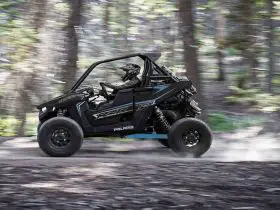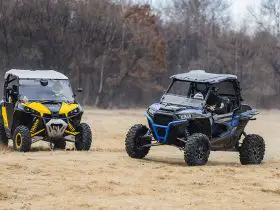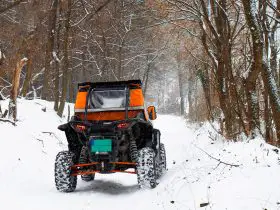The limits on pollution laws are usually in the range of 92-96dB. The quietest UTVs are the electric ones, no question about it. Among the gas-powered side by sides these 6 models are known to be quieter:
- Kawasaki Mule 4010
- Honda Pioneer 700
- Textron Off Road Prowler Pro XT
- Polaris Ranger XP 900
- Jonh Deere Gator XUV590E
- Yamaha Wolverine X4
The first sign of a side-by-side approaching is a powerful intense noise of these four-wheelers. Plenty of UTV riders enjoy the loud roar of their engines as they climb the dunes or rush through the trails. Still, many side-by-side users would like their machines to be a bit quieter, for various reasons.
Raucous sounds that follow you as you ride are the unavoidable trade-off for the muscle of powerful engines and open design, but some models that emit lower dB levels (not counting battery-operated ones). Also, if you tinker a little with your stock vehicle, either in a DIY way or in the workshop, you can achieve a quieter ride.
Table of Contents
Why Are the Side-By-Sides so Loud?
Lack of Insulation
Even when on idle, gas UTVs tend to be louder than a car. One of the reasons is that, unlike cars, they have less soundproofing and coverage around the engine the parts. When you pop the hood on a car there are covers everywhere, and most of those covers have insulation on the backside. To keep the weight and the cost down, and performance as high as possible, side-by-side manufacturers use way less insulating materials than cars.
Cabin
The dB levels, already pretty high, only amplify inside of the cabin. The roof and the windscreens ack as the sound reflectors, and enhance the vehicle noise instead of it spreading in the surroundings. The fact that most of the panels are made of smooth and flat materials doesn’t help either.
Exhaust
Exhaust noise is probably the strongest and the most annoying of all. While the cars have resonators, multiple catalytic converters, and a rather large muffler to help reduce sound levels, UTVs simply don’t have enough space for all of this. And if it did fit, it would significantly influence weight and performance.
Intake
Intake noise also contributes to the overall racket. UTVs don’t have resonators on the intake that will keep the sound levels down.
Dump-Beds
Ont top of all of this, metal or plastic that the dump-bed are made of resonates with any sound that the vehicle makes. They basically act as an amplifier for every clank, bong, cling, and jangle your machine produces.
Transmission and Engine
Some components and systems commonly used in side-by-sides, such as CVT transmission with external belts and clutches contribute a great deal to practicality and agility. But, at the same time, the belt friction and gear grinding just add to the already high noise levels.
The engine design doesn’t do too much for the quiet ride either. Camshafts and pistons set in the single big bore cylinders make a lot of noise with every movement. Multi-cylinder engines would be quieter, but would also increase the overall cost and weight.
Why Do People Want Quiter UTVs?
Laws and Regulations
Plenty of states have lately introduced noise pollution laws making it illegal to ride vehicles that surpass the set limit. The limits are usually in the range of 92 to 96 dB. Repeated violations of these regulations have already led to the closing of some off-road trails and areas for UTV and ATV riders.
Damage to the Hearing
Over the long term, exposure to loud noise produced by UTVs will definitely influence your hearing. This is especially the case for those using UTVs daily, such as farmers. Any constant exposure to noises above 85 dB can be damaging to your ears. While using hearing protection equipment will help, if you are a frequent side-by-side user, opting for a quieter vehicle will probably be a good idea, health-wise.
The Intended Use of the UTV
UTV is more and more becoming a preferred vehicle for hunting trips. It’s smaller than the jeep or truck, agile, fuel-efficient, and with plenty of space for hunting equipment. But, it’s clear that the loud roaring machine might not be the best choice when going after the wild animals. So, many hunters are more than interested in finding the quieter UTVs or reducing the sound levels on the one they already have. The same goes for bird watchers or anyone else trying to enjoy the wildlife.
Many people seeking quieter side-by-sides use them for recreational purposes. They just want to have a vehicle that will enable them to have a comfortable, enjoyable, and quit ride away from the main roads. A lot of riders make use of UTV’s spaciousness to have nature family trips. In that case, they want to be able to hear one another over the engine noise.
Aftermarket and DIY Solutions to Quit Down the UTV
Using Exhaust Silencers
Probably the easiest way to reduce some noise from your UTV is to install a better or an extra exhaust silencer. There is a vast offer of aftermarket silencers available and installation is rather simple and straight forward if you have some mechanical knowledge and necessary tools. If not, you should leave to your local UTV workshop to perform this procedure. There you’ll also get the best advice on the silencer that’s the best fit for your muffler. This may reduce the dB levels by the whole 25%. You can also consider replacing the stock muffler and getting a new one.
Packing the Muffler
If you’re operating on a budget, you can try packing the muffler. This can be done with sound dampening materials. Although the cheapest solution, it may not be the most practical. Packing the muffler can restrict the airflow and cause the engine to overheat.
Changing the Tires
Improper of underinflated tires can also contribute to the higher noise level of your vehicle. especially if you’re using the thinner ones. Make sure that your tires are always properly inflated or replace them with the tires that are specially intended for reducing the noise. These tires are available with some manufacturers who use special rubber materials to lessen the noise during the contact with the road.
There’s plenty of other little things you can do to reduce the dB levels at least by some. Make sure all of the components of your UTV are tight and not dangling. Check for loose bolts and tighten them. Adjust your driving style, especially if you drive manual. There’s no need to constantly crang the throttle, getting to the highest gear and driving slower should help reduce the noise.
The Quietest UTV’s on the Market
Manufacturers usually follow market demands and since a lot of users still think that loud equals powerful, they don’t bother too much about reducing the dB levels of their vehicles. But, lately, there has been some improvement regarding the offer of quieter UTVs. It started with European and Japanese manufacturers and their US counterparts soon followed. For those looking for a quieter side-by-sides, here are some suggestions:
- Kawasaki Mule 4010
- Honda Pioneer 700
- Textron Off Road Prowler Pro XT
- Polaris Ranger XP 900
- Jonh Deere Gator XUV590E
- Yamaha Wolverine X4








